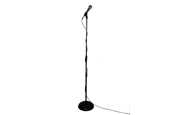
Microphone stand
Encyclopedia

Microphone
A microphone is an acoustic-to-electric transducer or sensor that converts sound into an electrical signal. In 1877, Emile Berliner invented the first microphone used as a telephone voice transmitter...
. It allows the microphone to be positioned in the studio, on stage or on location without requiring a person to hold it.
The most basic microphone stand is called a "straight stand". It uses a dome
Dome
A dome is a structural element of architecture that resembles the hollow upper half of a sphere. Dome structures made of various materials have a long architectural lineage extending into prehistory....
-shaped round metal base into which is threaded a post for mounting the microphone. This post may be made up of two or more telescoping tubes that fit inside each other, allowing for quick, one-handed height adjustment of the stand. The mechanism for adjusting the height is called the clutch.
There are various versions of the straight stand known as the "desk stand" (short version of straight stand) and heavy duty microphone stand (heavier base and larger tubes) to handle heavy microphones. The tubes used on the straight stand usually have a shiny chrome plating
Chrome plating
Chrome plating, often referred to simply as chrome, is a technique of electroplating a thin layer of chromium onto a metal object. The chromed layer can be decorative, provide corrosion resistance, ease cleaning procedures, or increase surface hardness.-Process:A component to be chrome plated will...
to resist scratching, but may also be finished in a matte
Matte
Matte may refer to:In film:* Matte , filmmaking and video production technology* Matte painting, a process of creating sets used in film and video* Matte box, a camera accessory for controlling lens glare...
black.
A very popular updated version of the straight stand uses the "folding tripod base stand", instead of the round, domed metal base. This folding base allows for easier packing of the stand when moving from location to location and reduces the weight of the stand. However, to compensate for the lack of weight at the base while still maintaining stability, the three "feet" of the tripod must extend out beyond the radius of a round base. The trade-off is that these "feet" may become a trip-hazard on a dark stage.
There are a number of accessories that make microphone stands more useful. Most of these are designed for getting the microphone closer to the user without placing the upright portion of the stand directly in front of the performer.
A "boom arm" can be attached to the top of the stand in order to allow the placement of the microphone to be moved in the horizontal plane
Horizontal plane
In geometry, physics, astronomy, geography, and related sciences, a plane is said to be horizontal at a given point if it is perpendicular to the gradient of the gravity field at that point— in other words, if apparent gravity makes a plumb bob hang perpendicular to the plane at that point.In...
. This might, for example, allow a guitar player to place the microphone directly in front of his mouth without having the upright portion of the stand in the way of the guitar. It also allows the microphone to be placed closer to the sound source when floor space is at a premium. This can be particularly useful when placing microphones on a drum stand when the microphone stands must compete for space with things like cymbal stands. Boom arms are offered both in fixed length and adjustable (telescoping) lengths.
Another handy device for adjusting microphone placement is a flexible "goose neck" tube. Made of a spiral-wound core of steel, goosenecks are made in various lengths and finishes and provide the ability to make minute changes in microphone position.
Microphones are attached using a detachable microphone holder screwed to the end of the boom. (Some microphones screw directly onto the boom.) The commonly used screw threads are:
- ⅝″ 27 threads per inch (tpi) Unified Straight thread (UNSUnified Thread StandardThe Unified Thread Standard defines a standard thread form and series—along with allowances, tolerances, and designations—for screw threads commonly used in the United States and Canada...
, U.S. and the rest of the world) - ¼″ BSWBritish Standard WhitworthBritish Standard Whitworth is one of a number of imperial unit based screw thread standards which use the same bolt heads and nut hexagonal sizes, the others being British Standard Fine thread and British Standard Cycle...
(uncommon in the U.S., used in the rest of the world) - ⅜″ BSW (uncommon in the U.S., used in the rest of the world)

